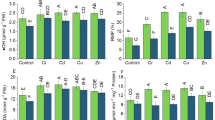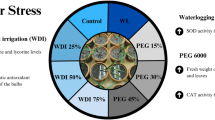Abstract
The influence of 24-epibrassinolide (EBR) on the regulation of antioxidant and pesticide detoxification systems in grape seedlings (Vitis vinifera L.) was investigated. The grapevine leaves were pretreated with different concentrations of EBR (0.10, 0.21 and 0.42 μM) before spraying with chlorothalonil (CHT) (600 times diluent). Compared with the control, CHT treatment showed an adverse effect on osmoregulation substances (soluble protein and free proline) and increased the content of malondialdehyde (MDA), activities of antioxidant enzymes and detoxification enzymes as well as the content of some non-enzymatic antioxidants. Compared to the CHT treatment alone, application of three concentrations of EBR resulted in an overall enhancement of these enzyme activities, soluble protein and free proline contents and reduction in MDA content. In addition, the expression of some key genes involved in CHT degradation including glutathione synthetase (GSH), glutathione S-transferase (GST), glutathione reductase (GR), P450 monooxygenase (P450) and MRP-type transporter (MRP) was analyzed. The transcriptional level of these genes increased in response to CHT treatment with the exception of GSH. EBR treatment of 0.10 μM could effectively promote expression of most genes and accelerate CHT degradation by 29 % as compared to only CHT treatment in grapevine leaves.


Similar content being viewed by others
Abbreviations
- APX:
-
Ascorbate peroxidase
- AsA:
-
Ascorbic acid
- CAT:
-
Catalase
- CHT:
-
Chlorothalonil
- EBR:
-
24-Epibrassinolide
- EDTA:
-
Ethylene diamine tetraacetic acid
- MDA:
-
Malondialdehyde
- GR:
-
Glutathione reductase
- GSH:
-
Reduced glutathione
- GST:
-
Glutathione transferase
- POD:
-
Peroxidase
- ROS:
-
Reactive oxygen species
- SOD:
-
Superoxide dismutase
References
Aebi H (1984) Catalase. Methods Enzymol 105:121–126
Ahammed GJ, Ruan YP, Zhou J, Xia XJ, Shi K, Zhou YH, Yu JQ (2013) Brassinosteroid alleviates polychlorinated biphenyls-induced oxidative stress by enhancing antioxidant enzymes activity in tomato. Chemosphere 90:2645–2653
Ali SS, Kumar GBS, Khan M, Doohan FM (2013) Brassinosteroid enhances resistance to fusarium diseases of barley. Phytopathology 103:1260–1267
Ashraf M, Akram NA, Arteca RN, Foolad MR (2010) The physiological, biochemical and molecular roles of brassinosteroids and salicylic acid in plant processes and salt tolerance. Crit Rev Plant Sci 29:162–190
Bajguz A (2000) Effect of brassinosteroids on nucleic acids and protein content in cultured cells of Chlorella vulgaris. Plant Physiol Biochem 38:209–215
Bartwal A, Mall R, Lohani P, Guru SK, Arora S (2013) Role of secondary metabolites and brassinosteroids in plant defense against environmental stresses. J Plant Growth Regul 32:216–232
Bates LS, Waldren RP, Teare ID (1973) Rapid determination of free proline for water-stress studies. Plant Soil 39:205–207
Beauchamp CO, Fridovich I (1971) Superoxide dismutase: improved assays and an assay applicable to acrylamide gels. Anal Biochem 44:276–287
Bradford M (1976) A rapid and sensitive method for the quantitation of microgram quantities of protein utilizing the principle of protein–dye binding. Anal Biochem 72:248–254
Cakmak I, Marschner H (1992) Magnesium-deficiency and high light-intensity enhance activities of superoxide-dismutase, ascorbate peroxidase, and glutathione-reductase in bean-leaves. Plant Physiol 98:1222–1227
Choudhary SP, Yu JQ, Yamaguchi-Shinozaki K, Shinozaki K, Tran LP (2012) Benefits of brassinosteroid crosstalk. Trends Plant Sci 17:594–605
Dalle-Donne I, Rossi R, Colombo G, Giustarini D, Milzani A (2009) Protein S-glutathionylation: a regulatory device from bacteria to humans. Trends Biochem Sci 34:85–96
Ding HD, Zhu XH, Zhu ZW, Yang SJ, Zha DS, Wu XX (2012) Amelioration of salt-induced oxidative stress in eggplant by application of 24-epibrassinolide. Biol Plant 56:767–770
Fariduddin Q, Mir BA, Yusuf M, Ahmad A (2013) Comparative roles of brassinosteroids and polyamines in salt stress tolerance. Acta Physiologiae Plantarum 35:2037–2053
Gomes M (2011) Physiological effects related to brassinosteroid application in plants. In: Hayat S, Ahmad S (eds) Brassinosteroids: a class of plant hormone. Springer, Dordrecht, pp 193–242
He Q, Huang JW, Yang XW, Yan X, He J, Li SP, Jiang JD (2016) Effect of pesticide residues in grapes on alcoholic fermentation and elimination of chlorothalonil inhibition by chlorothalonil hydrolytic dehalogenase. Food Control 64:70–76
Hodges DM, DeLong JM, Forney CF, Prange RK (1999) Improving the thiobarbituric acid-reactive-substances assay for estimating lipid peroxidation in plant tissues containing anthocyanin and other interfering compounds. Planta 207:604–611
Huang B, Chu CH, Chen SL, Juan HF, Chen YM (2006) A proteomics study of the mung bean epicotyl regulated by brassinosteroids under conditions of chilling stress. Cell Mol Biol Lett 11:264–278
Hussain S, Siddique T, Arshad M, Saleem M (2009) Bioremediation and phytoremediation of pesticides: recent advances. Crit Rev Env Sci Tec 39:843–907
Jiang MY, Zhang JH (2001) Effect of abscisic acid on active oxygen species, antioxidative defence system and oxidative damage in leaves of maize seedlings. Plant Cell Physiol 42:1265–1273
Li BQ, Zhang CF, Cao BH, Qin GZ, Wang WH, Tian SP (2012) Brassinolide enhances cold stress tolerance of fruit by regulating plasma membrane proteins and lipids. Amino Acids 43:2469–2480
Liu YJ, Zhao ZG, Si J, Di CX, Han J, An LZ (2009) Brassinosteroids alleviate chilling-induced oxidative damage by enhancing antioxidant defense system in suspension cultured cells of Chorispora bungeana. Plant Growth Regul 59:207–214
Livak KJ, Schmittgen TD (2001) Analysis of relative gene expression data using real-time quantitative PCR and the 2–∆∆CT method. Methods 25:402–408
Mauch F, Dudler R (1993) Differential induction of distinct glutathione-S-transferases of wheat by xenobiotics and by pathogen attack. Plant Physiol 102:1193–1201
Nakano Y, Asada K (1981) Hydrogen peroxide is scavenged by ascorbate-specific peroxidase in spinach chloroplasts. Plant Cell Physiol 22:867–880
Rahman I, Kode A, Biswas SK (2006) Assay for quantitative determination of glutathione and glutathione disulfide levels using enzymatic recycling method. Nat Protoc 1:3159–3165
Sharma I, Bhardwaj R, Pati PK (2012) Mitigation of adverse effects of chlorpyrifos by 24-epibrassinolide and analysis of stress markers in a rice variety Pusa Basmati-1. Ecotox Environ Safe 85:72–81
Sharma I, Bhardwaj R, Pati PK (2013a) Stress modulation response of 24-epibrassinolide against imidacloprid in an elite indica rice variety Pusa Basmati-1. Pestic Biochem Phys 105:144–153
Sharma I, Ching E, Saini S, Bhardwaj R, Pati PK (2013b) Exogenous application of brassinosteroid offers tolerance to salinity by altering stress responses in rice variety Pusa Basmati-1. Plant Physiol Biochem 69:17–26
Sharma A, Kumar V, Singh R, Thukral AK, Bhardwaj R (2015) 24-Epibrassinolide induces the synthesis of phytochemicals effected by imidacloprid pesticide stress in Brassica juncea L. J Pharmacognosy Phytochem 4(3):60–64
Sharma A, Bhardwaj R, Kumar V, Thukral AK (2016a) GC-MS studies reveal stimulated pesticide detoxification by brassinolide application in Brassica juncea L. plants. Environ Sci Pollut Res Int 23:14518–14525
Sharma A, Kumar V, Bhardwaj R, Thukral AK (2016b) Seed pre-soaking with 24-epibrassinolide reduces the imidacloprid pesticide residues in green pods of Brassica juncea L.. Toxicol Environ Chem:1–9
Sharma A, Kumar V, Thukral AK, Bhardwaj R (2016c) Epibrassinolide-imidacloprid interaction enhances non-enzymatic antioxidants in Brassica juncea L. Indian J Plant Physiol 21:70–75
Sirhindi G (2013) Brassinosteroids: Biosynthesis and role in growth, development and thermotolerance responses. In: Rout GR, Das AB (eds) Molecular stress physiology of plants. Springer, New York, pp 309–329
Sun LW, Ren L, Peng T, Xin LH, Qian HF, Fu ZW (2015) Carbon dioxide enrichment and brassinosteroid pretreatment alleviate chlorpyrifos phytotoxicity under suboptimal light and temperature conditions in tomato. Sci Hortic 192:256–263
Szabados L, Savouré A (2010) Proline: a multifunctional amino acid. Trends Plant Sci 15:89–97
Thomas RL, Jen JJ, Morrr CV (1982) Changes in soluble and bound peroxidase—IAA oxidase during tomato fruit development. J Food Sci 47:158–161
Van Eerd LL, Hoagland RE, Zablotowicz RM, Hall JC (2003) Pesticide metabolism in plants and microorganisms. Weed Sci 51:472–495
Wang JT, Jiang YP, Chen SC, Xia XJ, Shi K, Zhou YH (2010) The different responses of glutathione-dependent detoxification pathway to fungicide chlorothalonil and carbendazim in tomato leaves. Chemosphere 79:958–965
Wang GL, Liang B, Li F, Li SP (2011) Recent advances in the biodegradation of chlorothalonil. Curr Microbiol 63:450–457
Wu XX, He J, Zhu ZW, Yang SJ, Zha DS (2014) Protection of photosynthesis and antioxidative system by 24-epibrassinolide in Solanum melongena under cold stress. Biol Plant 58:185–188
Xi ZM, Wang ZZ, Fang YL, Hu ZY, Hu Y, Deng MM, Zhang ZW (2013) Effects of 24-epibrassinolide on antioxidation defense and osmoregulation systems of young grapevines (V. vinifera L.) under chilling stress. Plant Growth Regul 71:57–65
Xia XJ, Huang YY, Wang L, Huang LF, Yu YL, Zhou YH, Yu JQ (2006) Pesticides-induced depression of photosynthesis was alleviated by 24-epibrassinolide pretreatment in Cucumis sativus L. Pestic Biochem Physiol 86:42–48
Xia XJ, Zhang Y, Wu JX, Wang JT, Zhou YH, Shi K, Yu YL, Yu JQ (2009) Brassinosteroids promote metabolism of pesticides in cucumber. J Agr Food Chem 57:8406–8413
Yang CJ, Zhang C, Lu YN, Jin JQ, Wang X- (2011) The mechanisms of brassinosteroids’ action: from signal transduction to plant development. Mol plant 4:588–600
Yin YL, Zhou Y, Zhou YH, Shi K, Zhou J, Yu YL, Yu JQ, Xia XJ (2016) Interplay between mitogen-activated protein kinase and nitric oxide in brassinosteroid-induced pesticide metabolism in Solanum lycopersicum. J Hazard Mater 316:221–231
Yuan GF, Jia CG, Li Z, Sun B, Zhang LP, Liu N, Wang QM (2010) Effect of brassinosteroids on drought resistance and abscisic acid concentration in tomato under water stress. Sci Hortic 126:103–108
Yusuf M, Fariduddin Q, Ahmad I, Ahmad A (2014) Brassinosteroid-mediated evaluation of antioxidant system and nitrogen metabolism in two contrasting cultivars of Vigna radiata under different levels of nickel. Physiol Mol Biol Plants 20:449–460
Zhan Y, Zhang MH (2012) PURE: A web-based decision support system to evaluate pesticide environmental risk for sustainable pest management practices in California. Ecotoxicol Environ Saf 82:104–113
Zhang YP, He J, Yang SJ, Chen YY (2014) Exogenous 24-epibrassinolide ameliorates high temperature-induced inhibition of growth and photosynthesis in Cucumis melo. Biol Plant 58:311–318
Zhou Y, Zhou YH, Xia XJ, Yu GB, Wang JT, Wu JX, Wang MM, Yang YX, Shi K, Yu YL, Chen ZX, Gan J., Yu JQ (2015) Brassinosteroids play a critical role in the regulation of pesticide metabolism in crop plants. Sci Rep 5:9018
Pesticide multiresidue Screen methods for determination of organophosphorus pesticides, organochlorine pesticides, pyrethroid pesticides and carbamate pesticides in vegetables and fruits. (2008). China, NY/T 761–2008:16–25
Acknowledgments
This study was supported by the National Technology System for Grape Industry (CARS-30-zp-9), the Natural Science Foundation of Shaanxi Province (2011JM3004). The authors gratefully acknowledge these institutions for funding.
Author contributions
Conceived and designed the experiments: Zhumei Xi, Wrote the manuscript and performed the experiments: Zhizhen Wang, Yue Jiang, Contributed reagents/materials/analysis tools: Xiaoqin Peng, Shiyan Xu, Hui Zhang, Jiangman Gao.
Author information
Authors and Affiliations
Corresponding author
Additional information
Zhizhen Wang and Yue Jiang have contributed equally to this work.
Electronic supplementary material
Below is the link to the electronic supplementary material.
Rights and permissions
About this article
Cite this article
Wang, Z., Jiang, Y., Peng, X. et al. Exogenous 24-epibrassinolide regulates antioxidant and pesticide detoxification systems in grapevine after chlorothalonil treatment. Plant Growth Regul 81, 455–466 (2017). https://doi.org/10.1007/s10725-016-0223-6
Received:
Accepted:
Published:
Issue Date:
DOI: https://doi.org/10.1007/s10725-016-0223-6




